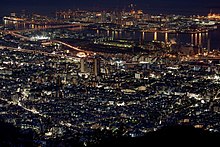Rokkō Island
Rokkō Island ( Japanese 六甲 ア イ ラ ン ド , Rokkō airando ) is a 5.95 km² artificial island in the Bay of Osaka in Japan . It forms the districts of Kōyō-chō-Nishi ( 向 洋 町 西 , "Kōyō-West"), Kōyō-chō-Naka ( 向 洋 町 中 , "Kōyō-middle") and Kōyō-chō-Higashi ( 向 洋 町 東 , "Kōyō- Ost ") in the district higashinada-ku of the city Kobe in the prefecture of Hyogo .
14,833 people live on Rokkō Island (October 2005) . After Port Island , it is the second large new land island of Kobe and an important part of the city's port, with which it is connected via a combined road and rail bridge and a motorway bridge.


Naming
The name comes from Rokkō , Kobe's local mountain , which the island is in front of. The district name Kōyō means something like "facing the ocean" or "facing the west (Europe)".
Urban area
The backfill work for Rokkō Island began in 1972, in March 1988 the first residents and business operators could move in, in 1992 the island was completed.
The western (-nishi) and eastern (-higashi) districts, with their spacious quays and warehouses, form exclusively the port area and handle a large part of the container handling in the port of Kobe . These parts of the city are practically uninhabited. The middle district is a business and residential area with high-rise, multi-family and single-family housing estates. Rokkō Island City is a popular district in the Hanshin area: streets and pedestrian zones have been laid out very generously and have a modern western flair. The high proportion of foreigners due to the Japanese headquarters of P&G and Nestlé as well as the English-language school Canadian Academy, which has around 500 students , also contribute to this atmosphere . The Island Center has two malls , sports and conference facilities, an information center by and for foreigners (Chic), a permanent international prefabricated house exhibition, a kind of imported goods coop, a gallery and the city's Kobe Fashion Museum .
The pedestrian zone invites you to stroll to the terrace-like park on the south side. The swimming pool theme park Aoia was in operation there until the great earthquake in Kobe in 1995 . A small private university has stood on the site since 2002: the Kobe International University originally had its campus in the Tarumi-ku district .
After years of stagnation due to steadily falling land prices, construction began again at the end of the 90s and mostly high-floor residential buildings were built on many of the fallow streets.
traffic
Rokkō Island has been connected to Hanshin Uozaki Station and JR Sumiyoshi Station by the people mover Rokkō Liner since 1990 .
The Hanshin Highway No. 5 ( Wangansen ) begins on Rokkō Island and connects the island to the highway network, the Harbor Highway leads to the center of Sannomiya and the neighboring Port Island.
The Kobe Bay Sheraton is also the stop about a third of the airport buses between Kobe and Kansai Airport .
General cargo, primarily containers, is handled in the extensive port facilities.
There is also a ferry port area with connections to Shōdoshima on the island of the same name , to Takamatsu and Niihama on Shikoku , to Ōita and Kitakyūshū (Shinmoji port) on Kyūshū , to Naha on Okinawa and Shanghai .
Facilities
- Chic Kobe (Community House & Information Center)
- Kobe Bay Sheraton Hotel
- Kobe Fashion Museum (since 1997)
- Municipal Koiso Memorial Gallery Kobe (since 1992)
- Canadian Academy English-language elementary, middle and high school with kindergarten
- Norwegian school (closed in 2005 due to unprofitability)
- German School Kobe International
Others
In the 1995 earthquake, which lasted around 20 seconds, a geological soil liquefaction effect occurred : the vibrations of the earth caused the solid particles to sink into a more compact arrangement in the water-containing fill soil. Some of the water can then remain on the ground. This phenomenon occurs particularly in the case of new landfills, the soil of which is not as solidified as that of natural islands and mainland.
Heavier buildings sank down to about 1 m, but the foundations went very deep, so that the building damage on Rokkō Island was very limited and, in contrast to the rest of the district area, there was almost no personal injury to complain about. A larger part of the urban area was still fallow at the time of the earthquake and soon housed several hundred container apartments.
Almost 2 km south of Rokkō Island, residual waste from 195 cities in the entire Kinki region, which has been processed in waste incineration plants , has been dumped in the Bay of Osaka since 1995 in a square area delimited by dams under the name Phoenix .
Web links
- Rokkō Island City website (Japanese)
- Map with the train stations of Higashinada in English
- Kobe City website
Individual evidence
- ↑ FBC
- ^ Discover Sea Road. In: 神 戸 フ ェ リ ー ガ イ ド . Port of Kobe, accessed November 10, 2012 (Japanese).
Coordinates: 34 ° 41 ′ N , 135 ° 16 ′ E